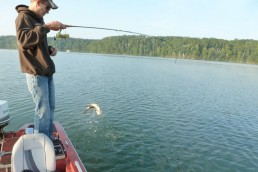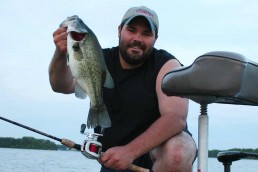Bass Jigs: Are They Ready for the Water?
SHARE THIS POST
Fishing a local bass tournament last summer, my partner and I knew that we were in the running to take home first place, and another big bass would surely do that and be the icing on the cake. Having fished with spinners and lipless crankbaits for most of the day, we decided to tie on some bass jigs with only 30 minutes to fish. After a few minutes of pitching into some cover along the shoreline, my tournament partner was able to haul out a largemouth weighing just a tad over 5 pounds. This was the fish we needed to claim first place. Without this one we were 9 ounces from the win and we owe it all to a properly modified jig.
Bass jigs are an amazing lure—they can either be jigged, pitched or you can simply swim them through the water. Jigs are great for catching big fish, but are they living up to their potential?
Not if you are fishing with them straight out of the package.
Fishing jigs usually come from the factory with a nylon-bristled weed guard. In a perfect fishing world, the guard will prevent vegetation and other junk from making contact with the point of the hook, thus making it a “weedless” lure. What actually happens with these thick weed guards is they prevent the bass from coming in contact with the hook, which means they are poorly hooked fish that can easily get off or miss strikes altogether.
To make your jig more productive you will need to trim some of the bristles off the guard. On a normal jig they will have around 30 strands of nylon on their guard. This number should be cut in half. To accomplish this, take a sharp pair of scissors and cut strands of the weed guard off where they attach to the body of the jig. Removal of the strands should be made equally around the body. This means to take the same amount from the sides, top and bottom. Also, make the cuts as close to the head as you possibly can. Now that the proper numbers of strands are removed, you need to cut the guard to length. I have found it best to cut the guard to a length right past the tip of the hook at a 45-degree angle with the strands closest to the hook being the longest.
Now that the weed guard is fine-tuned, let’s focus on the skirt. The skirt is the bread and butter of the jig’s presentation. Jigs are normally either made of rubber or nylon and not a lot of work has to be done to make it sleek as it moves through the water.
Are you enjoying this post?
You can be among the first to get the latest info on where to go, what to use and how to use it!
For starters, grab the jig by the head and allow the skirt to fall down. With the sharp scissors, begin in the middle of the skirt and a make 45-degree angle to the left, then to the right. You should end up with a skirt that is longer in the middle than on the sides. The overall length should be about 1 inch from the bend of the hook.
When fishing, it is every angler’s hope of catching big fish. That is why jigs come with hooks that appear to be oversized. To help these big hooks catch big fish, it is a good idea to widen the gap between the shaft and the bend of the hook.
Take a pair of pliers and grab the hook right behind the barb and bend. It does not take a lot of bend to help considerably. Flattening the barb or bending the hook too much will have a negative effect on putting more fish in the boat so be careful not to bend the hook gap more than 8 to 10 percent of what it was when you took it out of the package.
Trailers are important with jigs. Usually they are either made out of plastic or rubber. Still, there are things that can be done to help them fish better.
The big trailers will slow down in regard to how fast the jig drops. If you would like for it to fall faster pick up the scissors again and trim of the length of the trailer.
It is even possible to change how the trailer moves through the water. For example, with frog-style baits you can cut from the legs up to the belly, causing it to flap as it moves through the water. Or, you can simply make small slices on one side of the trailer being careful not to cut all the way through.
I hope these tips for modifying your bass jig helps. Give these changes a try and you might just catch more fish with what is already a bass-catching machine.
MWO
SHARE THIS POST
You may also like...
0 CommentsGreat Shallow-water Bass Action Right Now
Did you enjoy this post?
You can be among the first to get the latest info on where to go, what to use and how to use it!
Jason Houser
Jason Houser is an avid outdoorsman from Central Illinois. Houser has been a full-time freelance writer since 2008. He is also the host of Jason Houser Outdoors, airing on the Hunt Channel. He can be found on Facebook at Jason Houser Outdoors or on the web at jasonhouseroutdoors.com.



